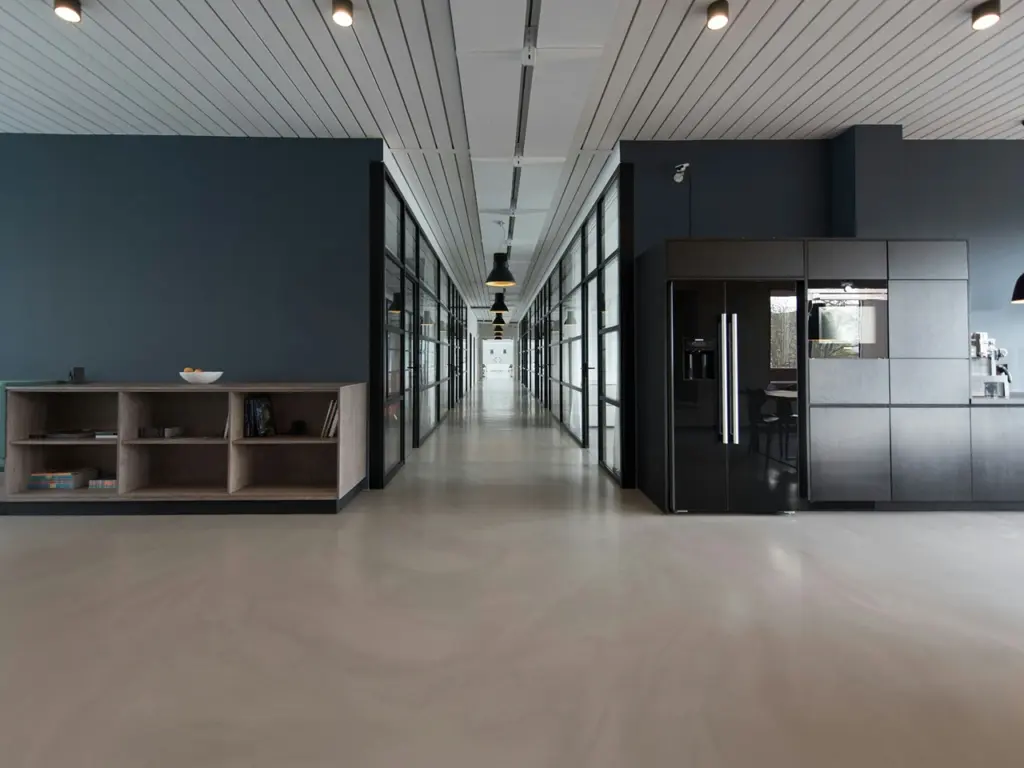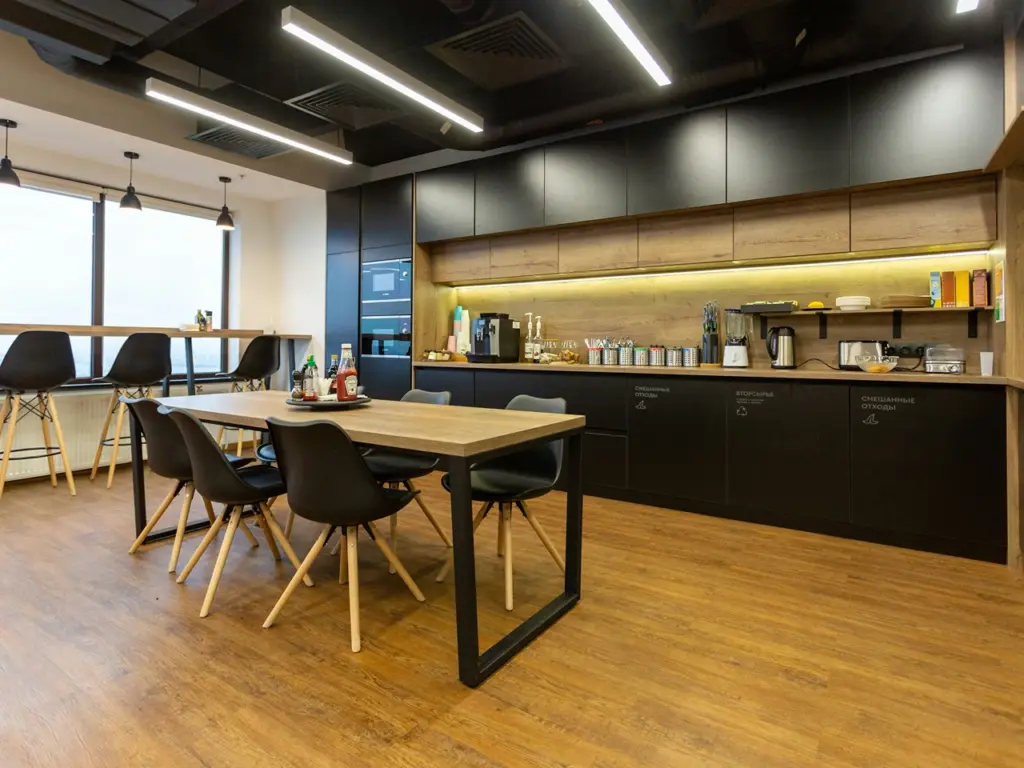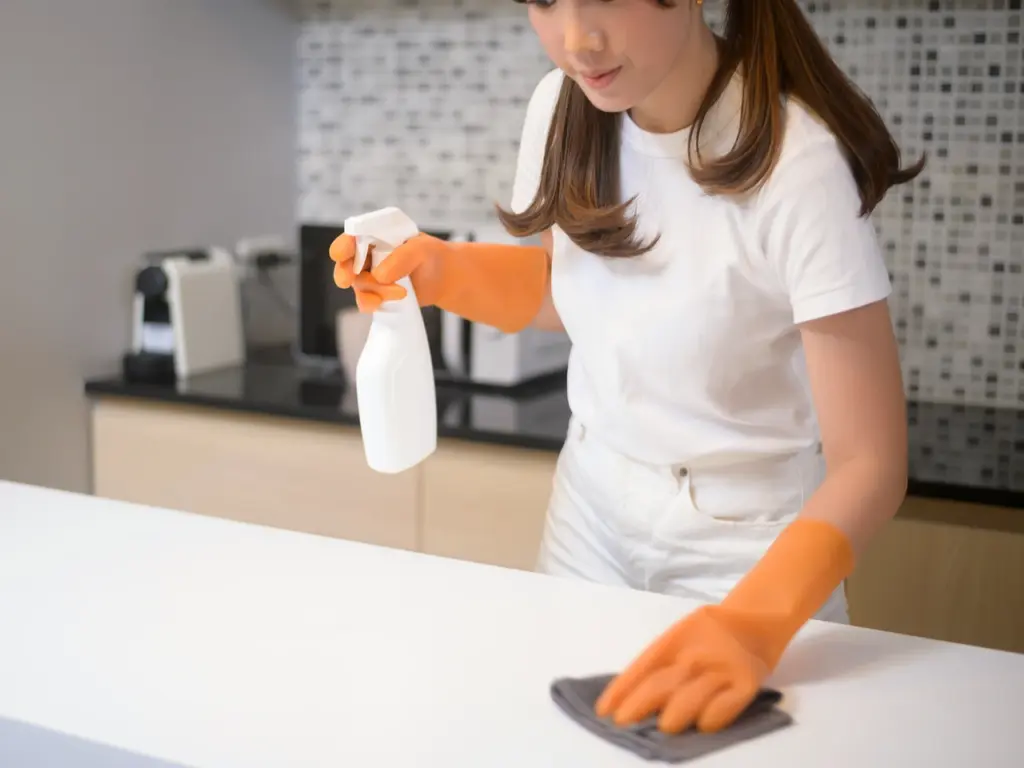Are you wondering how to transform your workplace kitchen into a vibrant hub that employees actually want to use? A thoughtfully designed office kitchen can be a hub for creativity, collaboration, and employee well-being. Yet, many office kitchens are overlooked, becoming bland and uninspiring spaces.
In this blog, you’ll discover practical ideas to transform your office design into a functional and inviting area that encourages productivity, fosters team connections, and leaves a lasting impression on both your staff and clients. We’ll explore key elements of a great office kitchen design, must-have features, and creative ideas to make it both practical and stylish.
Why is a Well-Designed Office Kitchen Important?

A well-designed office kitchen goes beyond being just a place to eat lunch. It serves as a social hub that significantly impacts your workplace culture. When employees have access to a functional space, they’re more likely to stay on-site during breaks, leading to increased employee satisfaction and improved retention rates.
Research shows that communal spaces like office kitchens foster collaboration and spontaneous interactions, leading to improved team dynamics. These casual encounters often spark brainstorming sessions that wouldn’t occur in formal meeting rooms. The kitchen becomes a natural spot to eat and recharge, contributing to better employee well-being by providing a much-needed break from the regular workspace.
Maximize Storage Space in Your Office Kitchen

Efficient storage solutions are essential for making the most of your office space. Here are some practical strategies to optimize your kitchen’s functionality and organization:
- Optimize Cabinet Space with Pull-Out Organizers: Pull-out organizers are a game-changer for kitchen cabinets, especially in tight or corner spaces. These organizers allow easy access to items stored in the back, maximizing every inch of available space. By installing pull-outs, you can reduce clutter and keep your office kitchen neat and efficient.
- Utilize Vertical Storage with Tall Cabinetry: Tall cabinets that extend to the ceiling are an excellent way to make use of vertical space in your office kitchen. It provides ample storage for less frequently used items while keeping the area visually organized. To maintain accessibility, consider adding a step stool or built-in ladder to your design.
- Incorporate Built-In Solutions Like Dispensers: Built-in systems, such as a dispenser for beverages, streamline functionality while saving counter space. These systems keep essential supplies organized and within easy reach, making them perfect for busy office kitchens. Additionally, they enhance the overall aesthetic by reducing visible clutter.
- Invest in Multi-Functional Furniture: Multi-functional furniture, such as a table that doubles as a workstation with built-in storage compartments, is ideal for compact office kitchens. These pieces serve dual purposes, providing space for tasks while also housing kitchen essentials. By combining functionality with storage, you can maximize utility without overcrowding the area.
These tips ensure your office kitchen remains a practical, tidy, and efficient space for everyone to use.
Create a Welcoming Office Kitchen Atmosphere

A well-designed office kitchen can elevate it from a purely functional space to an inviting hub for interaction and relaxation. Here are key elements to consider:
- Embrace Scandinavian Design: Opt for a Scandinavian-inspired aesthetic characterized by clean lines, neutral tones, and natural materials. This design style promotes simplicity and warmth, making the kitchen feel both modern and cozy. Incorporating natural wood finishes, muted colours, and minimalist furniture fosters a calm yet inviting atmosphere that aligns with team spirit.
- Use Lighting to Set the Tone: Lighting plays a critical role in creating a warm atmosphere. Combine natural light with layered artificial lighting, such as pendant lights and under-cabinet fixtures, to balance brightness and warmth. Use dimmable options to adjust the ambiance throughout the day, ensuring the space feels inviting for both casual coffee breaks and team discussions.
- Choose an Open Layout: An open layout encourages movement and interaction among team members. By eliminating unnecessary barriers, you create a space that feels larger and more accessible. This design not only improves functionality but also enhances the sense of community, supporting collaboration and informal conversations.
- Add Homely Touches: Personalize the space with homely elements such as indoor plants, cozy textiles, or local artwork. These details soften the environment, making it feel more welcoming and less institutional. Adding personal touches can also reflect your team’s personality, reinforcing a sense of belonging and pride in the shared space.
- Balance Aesthetics with Practicality: A well-planned office kitchen design should be visually appealing while supporting everyday functionality. Consider storage solutions, durable materials, and ergonomic layouts to ensure the kitchen meets individual needs without sacrificing style. Striking this balance creates an inviting space where team members can relax, recharge, and connect.
Incorporate Sustainable Office Kitchen Design

Designing an eco-conscious office kitchen involves thoughtful choices that balance functionality and environmental responsibility. The focus should be on sustainable materials and practices that align with modern green standards. Key considerations include:
- Energy-Efficient Appliances: Installing energy-efficient appliances is a cornerstone of sustainable kitchen design. Opt for Energy Star-certified devices that consume less power, such as refrigerators, dishwashers, and microwaves. These not only lower electricity bills but also reduce the kitchen’s carbon footprint over time.
- Sustainable and Easy-Care Surfaces: Select surfaces made from renewable or recycled materials, like bamboo, reclaimed wood, or recycled composites. These materials are durable, require minimal maintenance, and align with eco-friendly principles. Easy-care surfaces also save time and resources in cleaning, further contributing to sustainability.
- Recycling and Composting Stations: Implementing sorting stations encourages proper waste management by making recycling and composting convenient. Clearly labelled bins for paper, plastic, organic waste, and general trash help staff adopt eco-conscious habits. This setup significantly reduces landfill contributions and promotes a culture of sustainability in the office.
- Fresh Fruit and Locally Sourced Produce: Adding a fresh fruit station with locally sourced produce not only supports local farmers but also reduces the environmental impact of long-distance food transport. It provides employees with a healthy snack option while emphasizing the importance of sustainable food choices.
- Water Filtration Systems: Installing water filtration systems eliminates the need for plastic water bottles, significantly reducing plastic waste in the office. These systems provide clean, filtered water on demand and promote the use of reusable bottles or cups among employees, fostering a greener workplace culture.
Smart Appliances and Technology Integration in Modern Office Kitchens

Modern office designs are evolving into efficient, tech-savvy spaces with the integration of smart appliances and advanced technology. These innovations not only enhance convenience but also foster productivity and collaboration in the workplace.
- Smart Coffee or Tea Stations: Transform your coffee breaks with programmable smart coffee or tea stations. These machines allow users to customize brewing settings for different tastes, ensuring every cup is perfect. With built-in timers and voice control compatibility, they can be programmed to prepare your preferred brew just as you walk into the kitchen.
- Mobile Control for Touch Device Users: Touch device users can now operate kitchen appliances seamlessly through mobile apps. Whether it’s adjusting the temperature of a smart refrigerator or preheating the oven, these apps provide convenience at your fingertips. This connectivity reduces downtime, making the modern office kitchen more efficient.
- Automated Kitchen Clean Scheduling Systems: Say goodbye to messy office kitchens with automated kitchen clean scheduling systems. These systems can schedule regular cleaning tasks for appliances such as dishwashers and air purifiers. Ensuring a clean and hygienic kitchen becomes effortless, even in busy workplaces.
- Built-in USB Ports and Wireless Charging Stations: High tables in modern office kitchens are now equipped with built-in USB ports and wireless charging stations. These features allow employees to stay connected and charge devices conveniently while enjoying their meals or coffee breaks. It fosters a functional yet relaxing environment for both work and leisure.
- Espresso Machines with Digital Customization: Espresso machines with digital customization options bring barista-level coffee experiences to your office. Users can adjust settings for grind size, water temperature, and brewing time to suit their preferences. This elevates the coffee culture in modern office kitchens, making it a hub for interaction and creativity.
Importance of Shared Kitchens in Fostering a Sense of Community

Shared kitchens are more than just functional spaces; they serve as hubs for collaboration and creativity, bringing people together in unique and meaningful ways. These spaces contribute to a sense of community in several key ways:
- Encouraging Team Spirit Through Informal Interactions: Shared kitchens provide opportunities for casual team spirit building by creating a relaxed environment where employees can connect beyond formal meetings. Whether it’s a quick chat over coffee or helping each other prepare meals, these moments foster stronger interpersonal bonds and improve workplace camaraderie. The informal nature of these spaces helps dissolve hierarchical barriers, making collaboration more natural and enjoyable.
- Fostering Brainstorming and Innovative Thinking: During coffee breaks or shared meals, kitchens often become impromptu brainstorming environments. The casual atmosphere encourages free-flowing conversations and the exchange of ideas, sparking creativity and innovation. These spontaneous discussions can lead to problem-solving and the generation of fresh perspectives that might not emerge in traditional meeting rooms.
- Building a Stronger Sense of Community Through Shared Experiences: Shared kitchens create opportunities for people to bond over shared experiences, such as cooking together, celebrating milestones, or simply enjoying a meal. These collective moments strengthen relationships and establish a sense of belonging, making the workplace feel more inclusive and welcoming.
- Encouraging Exploration Through Sensory Experiences: Shared kitchens offer a space where employees can explore new tastes and textures, creating opportunities for discovery and connection. Trying out new recipes or sharing cultural dishes allows people to learn from one another and appreciate diverse backgrounds. This sensory exploration enhances collaboration by creating a platform for curiosity and mutual respect.
- Providing a Versatile Space for Continuous Engagement: Shared kitchens are in constant use throughout the day, supporting a variety of gatherings, from informal chats to team celebrations. Their versatility makes them a central hub for social interaction, ensuring that employees have a consistent space to connect, recharge, and collaborate, no matter the time of day.
By blending functionality with opportunities for collaboration and creativity, shared kitchens play a vital role in building team spirit, fostering innovation, and cultivating a strong sense of community in any organization.
Workspace Kitchens Should Cater to Diverse Dietary Needs

A well-planned kitchen considers various dietary requirements while maintaining a welcoming atmosphere:
- Dedicated Storage Areas for Diverse Needs: A workspace kitchen should include multiple cabinet fronts to provide separated storage areas for different dietary requirements. This ensures that individuals with specific needs, such as allergies or dietary restrictions, feel secure and respected in their food storage. Clearly organized cabinets maintain a welcoming atmosphere by reducing the risk of cross-contamination and making it easier to find designated items.
- Specialized Worktops for Dietary Preparation: Designated worktops allow for separate preparation areas tailored to various dietary needs. For example, a specific worktop can be reserved for gluten-free or vegetarian cooking, preventing mix-ups and ensuring a safe environment for everyone. This thoughtful layout contributes to a harmonious and welcoming atmosphere by showing respect for individual preferences and safety concerns.
- Effective Labeling Systems: A clear labelling system for items like shared condiments and ingredients ensures that everyone understands what is available and safe to use. Labels can indicate whether an item is vegan, allergen-free, or gluten-free, promoting transparency and inclusivity. This system simplifies communication among team members and helps maintain an organized and welcoming kitchen environment.
- Organized Refrigeration Space: Adequate refrigeration space with clearly organized sections allows for the proper separation of foods based on dietary requirements. Labelled shelves or compartments ensure that allergen-sensitive or special diet items remain uncontaminated. This organization not only supports safety but also maintains a welcoming and respectful shared kitchen environment.
- Separate Utensil Sets for Diverse Needs: Providing separate utensil sets for different dietary requirements prevents cross-contamination and accommodates individuals with unique needs. For instance, colour-coded or clearly labelled utensils can distinguish between general use and those intended for specific diets, like vegetarian or kosher. This thoughtful approach fosters a welcoming atmosphere by prioritizing health and respect for everyone’s preferences.
Maintenance and Kitchen Cleaning Considerations for a Hygienic Workplace Kitchen

Keep your office kitchen spotless and functional by following these key practices:
Use Durable and Hygienic Materials
- Choose materials like non-porous surfaces for countertops and tables to resist stains and spills. These materials are easier to wipe clean and help maintain a hygienic environment.
- Opt for easy-to-clean cabinet with antimicrobial properties to reduce the spread of bacteria and germs. This ensures the storage areas remain sanitary and visually appealing.
Regular Cleaning of Appliances
- Establish a routine cleaning schedule for appliances. Regular maintenance prevents the buildup of food residues and ensures these appliances operate efficiently.
- Encourage staff to clean appliances immediately after use, reducing the risk of cross-contamination and keeping the kitchen tidy throughout the day.
Stock and Organize Cleaning Supplies
- Provide an adequate stock of cleaning supplies, such as all-purpose cleaners, sponges, and paper towels, in easily accessible locations. This encourages employees to clean up after themselves.
- Strategically place paper towel dispensers and sanitizing stations near high-use areas like the sink and countertops to promote quick clean-ups and better hygiene.
By implementing these simple yet effective measures, your office kitchen can remain a hygienic and welcoming space for everyone.
Final Thoughts
Your office kitchen has the potential to be much more than a breakroom—it can become the heart of your workplace. It’s a space that fosters collaboration, well-being, and a sense of community. A well-maintained kitchen should support all workplace scenarios while making room for growth and adaptation to changing needs. These office kitchen design ideas ensure your kitchen remains a functional space that’s both practical and inviting.
By incorporating functional layouts, thoughtful details, and modern innovations, you can create an inviting environment that inspires connection and productivity. Small changes can make a big impact, turning your kitchen into a central hub your team will appreciate every day.
Frequently Asked Questions
How can I improve the look of my office kitchen to align with modern office design trends?
- Incorporate Minimalist Design Elements: Focus on clean lines, neutral colours, and sleek finishes to create a modern aesthetic that complements the rest of your office interiors.
- Add Functional Furnishing: Invest in multi-purpose furniture, such as foldable tables or seating with storage, to balance form and function.
- Upgrade Lighting Fixtures: Use pendant lights or under-cabinet lighting to highlight key features of the kitchen while setting a welcoming tone.
- Decorate with Personal Touches: Include indoor plants, artwork, or branded elements to make the kitchen look more inviting and reflective of your team’s culture.
- Choose a Consistent Colour Palette: Select colours and materials that match the overall office design to maintain visual cohesion.
What are the essential kitchen features for an office kitchen to be fully equipped and functional?
- Energy-Efficient Coffee Makers: A coffee maker is a must-have for employee breaks; choose one with programmable features to suit diverse tastes.
- Ample Cabinet and Drawer Space: Provide enough storage for utensils, dishes, and pantry items, ensuring easy organization and accessibility.
- Durable Countertops: Select easy-to-clean surfaces that are resistant to stains and scratches, ensuring long-term use.
- Refrigeration and Storage Solutions: Incorporate spacious refrigerators and tall cabinets for efficient storage of perishable and non-perishable items.
- Dishwashing Facilities: Install a dishwasher to streamline cleaning and maintain a hygienic workspace.
How do I design an office kitchen that provides enough space while being practical?
- Optimize Vertical Storage: Use tall cabinetry and wall-mounted shelves to make the most of vertical space, ensuring enough storage without overcrowding the room.
- Create a Spacious Layout: Design an open kitchen layout with clear zones for food prep, storage, and seating to ensure smooth workflow and reduce clutter.
- Invest in Multi-Functional Furniture: Include foldable tables or island units with built-in storage to maximize utility in a compact space.
- Incorporate Built-In Appliances: Save space by using built-in ovens, microwaves, and dispensers for a sleek and efficient kitchen look.
- Design Wide Walkways: Ensure pathways are spacious enough for multiple people to move around comfortably, supporting a collaborative atmosphere.
What are some key design elements to make the office kitchen more inviting for employees?
- Focus on Ergonomic Furnishing: Provide comfortable seating and worktops at the right height to encourage employees to spend time in the kitchen.
- Use Warm and Layered Lighting: Combine natural light with dimmable pendant lights or LED fixtures to create a relaxing atmosphere.
- Include Social Spaces: Add a communal dining table or cozy corner seating to encourage interaction and team bonding.
- Add Stylish Cabinet and Drawer Designs: Choose cabinets with sleek handles and finishes to elevate the aesthetic appeal of the kitchen.
- Decorate with Welcoming Touches: Use homely elements like indoor plants, cushions, and curated artwork to make the space feel less corporate.
How can I ensure an office kitchen is easy to clean and maintain while staying fully functional?
- Choose Non-Porous Surfaces: Use materials like stainless steel or quartz for countertops, which are stain-resistant and easy to clean.
- Install Easy-to-Clean Cabinets: Opt for smooth cabinet fronts with antimicrobial finishes to maintain hygiene and reduce cleaning time.
- Encourage Organization: Provide labelled storage compartments to help employees keep items neatly arranged and accessible.
- Stock Cleaning Supplies: Make cleaning supplies like sponges, wipes, and all-purpose cleaners easily available in the kitchen.
- Establish Cleaning Routines: Create a shared schedule for regular maintenance of appliances and surfaces to keep the kitchen spotless.

